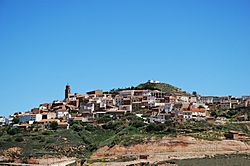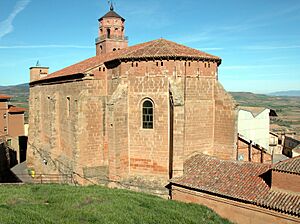Ausejo facts for kids
Quick facts for kids
Ausejo
|
||
|---|---|---|

View of Ausejo
|
||
|
||
| Country | ||
| Autonomous Community | ||
| Province | ||
| Comarca | Logroño | |
| Area | ||
| • Total | 56.58 km2 (21.85 sq mi) | |
| Elevation | 560 m (1,840 ft) | |
| Population
(2018)
|
||
| • Total | 754 | |
| • Density | 13.326/km2 (34.515/sq mi) | |
| Postal code |
26513
|
|
Ausejo is a charming town and municipality located in La Rioja, a beautiful region in Spain. It covers an area of about 56.58 square kilometers. As of 2018, around 754 people lived here.
Contents
Exploring Ausejo's Landscape
Ausejo is built on a hill that was once used for mining. You can still find ancient wineries here. The village offers amazing views of wide, flat plains with terraces, located south of the Ebro river. The highest point in the village is called La Estrella, which stands at 754 meters high.
A Glimpse into Ausejo's Past
Ausejo has a long and interesting history, often linked to important events in Spain.
Early History and Royal Agreements
In the past, kings often fought over control of towns like Ausejo. Henry II of Castile managed to get back areas that had been taken by Alfonso VIII. These included Logroño, Navarrete, Entrena, Ausejo, and Autol. To make peace, the kings of Castile and Navarre signed a ten-year truce.
However, the king of Navarre, Sancho, seemed to delay giving up the towns. So, the Castilian king started a campaign to take more villages and castles. Eventually, Sancho the Wise agreed to let Alfonso VIII choose someone to look after Logroño, Navarrete, Ausejo, and Autol.
Later Conflicts and Agreements
New problems arose when Sancho VII the Strong became king of Navarre. In 1207, new truces were signed in Guadalajara. Each king gave up three castles as a guarantee of peace. Navarre gave Irurita, Inzura, and San Adrián. Spain gave Clavijo, Jubera, and Ausejo.
Ausejo Under New Lords
On October 29, 1385, Juan Ramirez de Arellano, a powerful lord, wrote his will. He left Ausejo, along with other towns, to his grandson. From then on, Ausejo was under the control of the counts of Murillo.
The Castle's Fate
Ausejo once had a castle, but it was taken apart in the early 1800s. It was already in bad shape. Its stones were needed to fix the local church. The church had been damaged by an earthquake in 1817.
Ausejo was part of the Soria province until 1833. That's when the province of Logroño (now La Rioja) was created.
Ausejo's Population Over Time
The population of Ausejo has changed a lot over the years. Here's a look at how it has grown and shrunk:
| Vertical bar chart demographic of Ausejo between 1857 and 2010 |
 |
| Legal population (1857–1897) according to the population census published by the Instituto Nacional de Estadística in the 19th century.
Legal population (1900–1991) or Resident population (2001) according to the population census published by the Instituto Nacional de Estadística. Population according to the municipal register of 2010 published by the Instituto Nacional de Estadística. |
Important Buildings and Landmarks
Ausejo has several historic buildings that are worth seeing.
Santa María Parish Church
This church is made of stone and brick. It was built between the 16th and 18th centuries. The church was damaged by an earthquake in 1817. It was rebuilt in 1840 using stones from the old castle. Inside, you can see beautiful old furniture and art from the 17th and 18th centuries.
Santa María de la Antigua Hermitage
This hermitage, or small church, was built in the 17th century. It's about two kilometers from the town. It has been repaired many times and looks very elegant. Inside, there's modern ceramic art and a beautiful 14th-century statue of the Virgin Mary.
Chapel of the Crucifix
This chapel is an old 16th-century building. It used to be an open space with arches. Later, most of its openings were closed up. Now, it has a nave, which is the main part of a church, that is three times its original size.
The Castle Ruins
At the top of the hill, you can find the remains of the old castle. It's very damaged, so it's hard to see what it looked like originally. You can still spot parts of two round towers and some walls. These pieces hint at the different fortresses that once stood there.
Festivals and Celebrations
Ausejo celebrates many traditional festivals throughout the year.
- New Year's Day (January 1): Young people, called quintos, go around the village to collect money. They use this money to organize a special dinner and a dance party later in April.
- Pilgrimage to Virgen de la Antigua (May 3): People go on a pilgrimage to the Shrine of the Virgen de la Antigua. They also bless the crops on this day.
- San Isidro Feast (May 15): This day honors San Isidro, the patron saint of farmers.
- San Juan and Bonfires (June 24): The feast of San Juan is celebrated with traditional bonfires in the Parramera district.
- Ecce Homo Festivities (August): These main festivities used to be in September. But after a vote in 1987, they were moved to August. This makes it easier for people from Ausejo who live elsewhere to come back and celebrate during their summer holidays.
- Virgen de la Antigua Day (August 9 & 15): There's a special day for the Virgen de la Antigua on August 9. On August 15, there's another pilgrimage to her shrine. The main festivities usually run from August 8th to 12th.
- San Miguel Feast (September 29): This day celebrates San Miguel.
Famous People from Ausejo
Ausejo has been home to several notable individuals throughout history:
- Pedro de Merino: A brave soldier who captured a French marshal during the Battle of Pavia in 1525.
- Juan Gonzalez del Centeno: Born in 1583, he became a secretary to King Philip IV.
- Francisco del Merino: Born in 1602, he worked as a notary for an important court called the Holy Office.
- Juan González de Tejada: An inquisitor in Valencia during the 17th century.
- Juan José Tejada: Born in 1768, he became a Bishop and a high-ranking leader in the Order of Mercy.
- Antonio Paz Merino: He was a counselor to King Charles IV.
Ausejo Anthem
Ausejo even has its own special song! Here are the lyrics:
En el mapa de Rioja existe un pueblo no olvidaré. Ausejo de mi vida, que aunque estés lejos le vengo a ver, porque tengo a mis padres y de las cuevas nunca me olvido es la tierra querida donde he nacido.
¡Ay, ay, ay! Mi Ausejo que aunque me voy no te olvido me acuerdo de Las Caveras, y las viñas del Hornillo.
También de Valdarrete, Piezas del Monte y Viayón, tierras inolvidables donde he dejado el puro sudor, y hemos bajado la senda y hemos subido a Piezas del Monte, la fuente de la Madre que no se seque y mane abundante.
Onda Villa, Onda Villa y el pozo que no se seque, si del pozo no sale agua, la hortaliza se me muere.
En Ausejo estoy para disfrutar no te olvidaré jamás.
See also
 In Spanish: Ausejo para niños
In Spanish: Ausejo para niños







